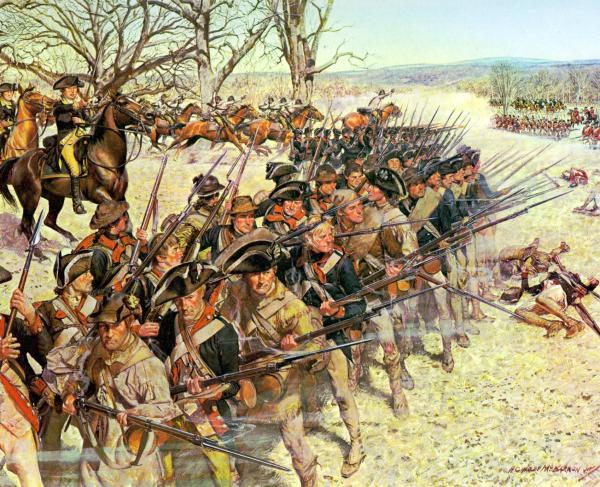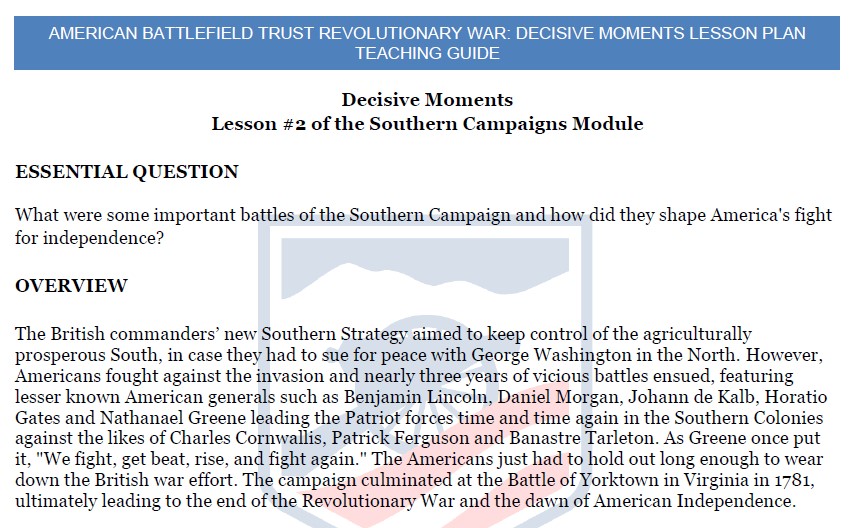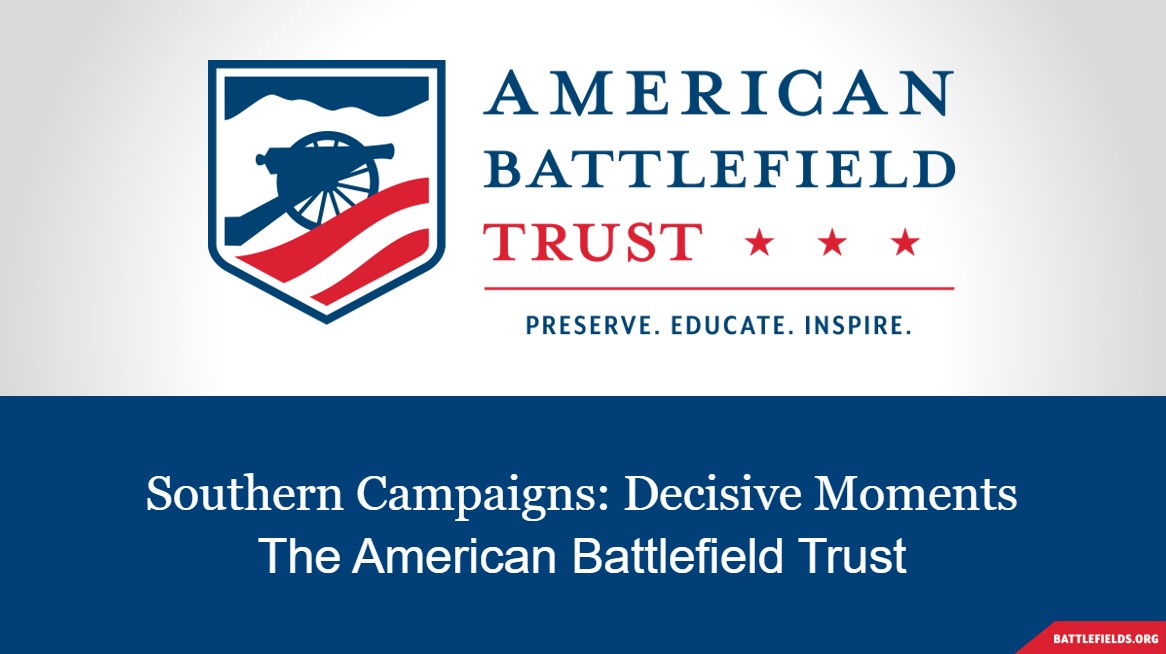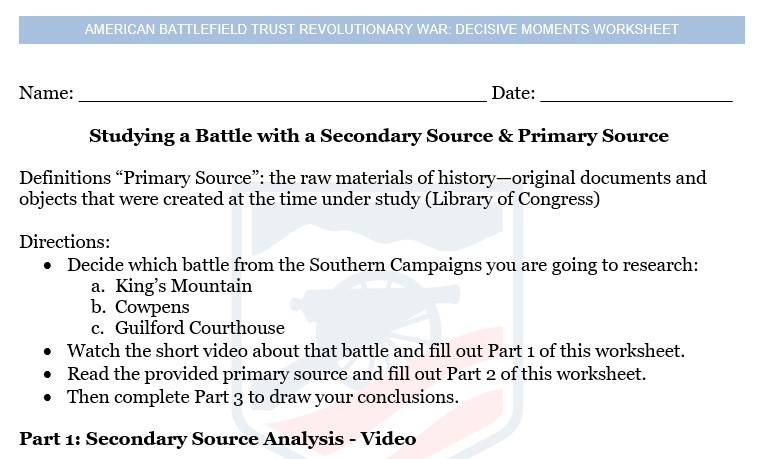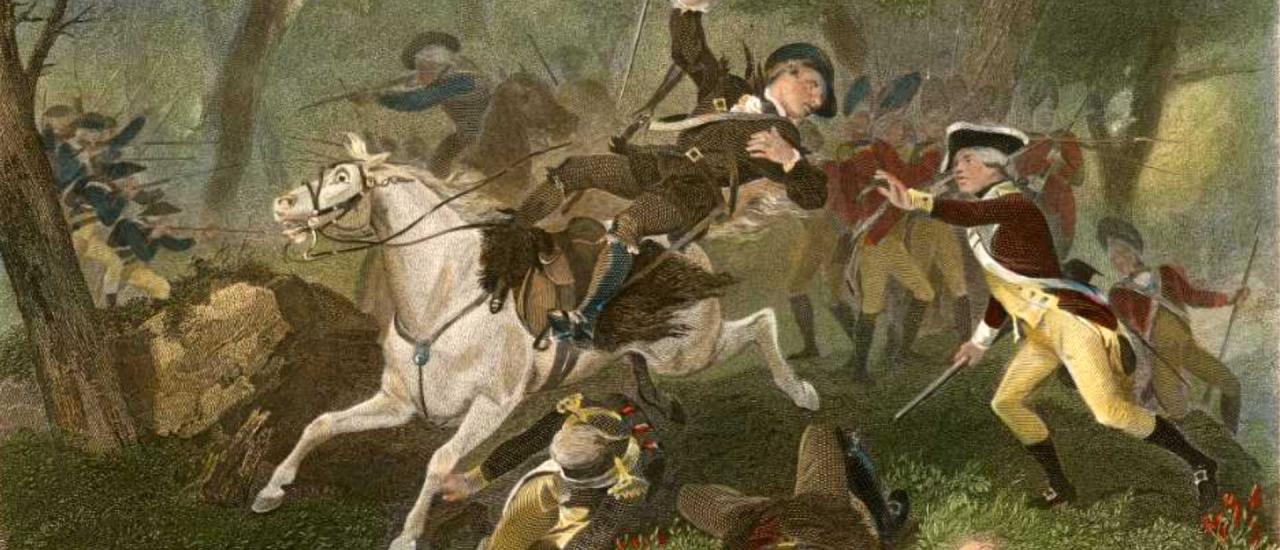
"Death of Major Ferguson at King's Mountain, 1863" by Alonzo Chappel
Decisive Moments Lesson Plan
A lesson plan for use in middle and high school classrooms.
The British commanders’ new Southern Strategy aimed to keep control of the agriculturally prosperous South, in case they had to sue for peace with George Washington in the North. However, Americans fought against the invasion and nearly three years of vicious battles ensued, featuring lesser known American generals such as Benjamin Lincoln, Daniel Morgan, Johann de Kalb, Horatio Gates and Nathanael Greene leading the Patriot forces time and time again in the Southern Colonies against the likes of Charles Cornwallis, Patrick Ferguson and Banastre Tarleton. As Greene once put it, "We fight, get beat, rise, and fight again." The Americans just had to hold out long enough to wear down the British war effort. The campaign culminated at the Battle of Yorktown in Virginia in 1781, ultimately leading to the end of the Revolutionary War and the dawn of American Independence.
This Lesson Plan can be used as a prepared resource by following this curriculum plan which aligns to NCSS and Common Core Standards.
This Lesson Plan's assets can also be used on their own as supplemental resources. The display format is prepared for easy access, exploring, and learning.
The Southern Campaigns Module
Upon completion of this lesson, the students will be able to:
1. Knowledge
- Describe some of the decisive moments in the Southern Campaigns of the Revolutionary War.
- Discuss the importance of the American perseverance and the British defeats during the Southern Campaigns which eventually led to the British surrender at Yorktown and the Treaty of Paris.
2. Comprehension/Application/Analysis
- Examine a secondary and primary source about a Revolutionary War battle and analyze findings.
3. Evaluation
- Evaluate and discuss some of the battles of the Southern Campaigns and their impact during the Revolutionary War.
Check out the Lesson Plan Teaching Guide for more instructions on using the prepared Lesson Plan.
Lesson Plan Primary and Secondary Source Activity:
- Use the Lesson’s PowerPoint to explore the context and history; the PowerPoint introduces Essential Questions and lays foundational knowledge about the conflict.
- Let students decide which battle to study. This could be in a group, as a class, or individually. It can be done as written work sheets or as verbal discussion.
- Distribute the primary source worksheet
- Watch one of or all of these short battle videos and have the students fill out Part 1 of their worksheet.
- Have the students read the primary source related to their chosen battle and fill out Part 2 of their worksheet.
- Finally, the students will fill out Part 3 of their worksheet to compare the Secondary Source (video) and the Primary Source and draw their conclusions.
- 6 selected primary sources are available under the “Primary Source” section this lesson plan page.
OPTIONAL HOMEWORK/ASSESSMENT/ADDITIONAL ACTIVITIES:
Option 1: Southern Campaigns Animated Map
Students can watch the 15-minute Southern Campaigns Animated Map and answer the comprehension questions.
Option 2: Biography and Letter
Students can research a military leader connected to the Southern Campaign or a battle in the Southern Campaign and identify his decisive moment. (There are selected biographies on the Lesson Plan Page.) Then, the students will write a letter as if they were writing to that military leader offering praise or concern about that decisive moment.
Option 3: Yorktown Battlefield Driving Tour
Hop in the car with Revolutionary War Historian Kristopher White for this all-encompassing virtual tour of the Yorktown Battlefield, where American Independence was won in 1781. Visit all of the pivotal locations including Cornwallis's Cave, Redoubts 9 & 10, the Moore House and Surrender Field. Students can take notes about a favorite location and write a summary of what they learned. (The entire driving tour is almost 100 minutes. You may want to select portions of the tour and the video is segmented for this option or reference!)
Common Core State Standards- ELA & History/Social Studies
Grades 6-8
- Key Ideas and Details:
- CCSS.ELA-LITERACY.RH.6-8.1
- Cite specific textual evidence to support analysis of primary and secondary sources.
- CCSS.ELA-LITERACY.RH.6-8.2
- Determine the central ideas or information of a primary or secondary source; provide an accurate summary of the source distinct from prior knowledge or opinions.
- CCSS.ELA-LITERACY.RH.6-8.1
- Craft and Structure:
- CCSS.ELA-LITERACY.RH.6-8.6
- Identify aspects of a text that reveal an author's point of view or purpose (e.g., loaded language, inclusion or avoidance of particular facts).
- CCSS.ELA-LITERACY.RH.6-8.6
- Integration of Knowledge and Ideas:
- CCSS.ELA-LITERACY.RH.6-8.9
- Analyze the relationship between a primary and secondary source on the same topic.
- CCSS.ELA-LITERACY.RH.6-8.9
Grades 9-10
- Key Ideas and Details:
- CCSS.ELA-LITERACY.RH.9-10.2
- Determine the central ideas or information of a primary or secondary source; provide an accurate summary of how key events or ideas develop over the course of the text.
- CCSS.ELA-LITERACY.RH.9-10.2
- Craft and Structure:
- CCSS.ELA-LITERACY.RH.9-10.6
- Compare the point of view of two or more authors for how they treat the same or similar topics, including which details they include and emphasize in their respective accounts.
- CCSS.ELA-LITERACY.RH.9-10.9
- Compare and contrast treatments of the same topic in several primary and secondary sources.
- CCSS.ELA-LITERACY.RH.9-10.6
Grades 10-12
- Key Ideas and Details:
- CCSS.ELA-LITERACY.RH.11-12.2
- Determine the central ideas or information of a primary or secondary source; provide an accurate summary that makes clear the relationships among the key details and ideas.
- CCSS.ELA-LITERACY.RH.11-12.3
- Evaluate various explanations for actions or events and determine which explanation best accords with textual evidence, acknowledging where the text leaves matters uncertain.
- CCSS.ELA-LITERACY.RH.11-12.2
- Craft and Structure:
- CCSS.ELA-LITERACY.RH.11-12.6
- Evaluate authors' differing points of view on the same historical event or issue by assessing the authors' claims, reasoning, and evidence.
- CCSS.ELA-LITERACY.RH.11-12.9
- Integrate information from diverse sources, both primary and secondary, into a coherent understanding of an idea or event, noting discrepancies among sources.
- CCSS.ELA-LITERACY.RH.11-12.6
Social Studies - National Council for the Social Studies
- Theme 2: Time, Continuity, and Change
- Theme 3: People, Places, and Environments
- Theme 5: Individuals, Groups, and Institutions
- Theme 6: Power, Authority, and Governance
This Lesson plan
contains the following:
4 Activities | 26 Resources
Audience: Middle school | High school
This Lesson plan is a part of:
Revolutionary War Curriculum | The Southern Campaigns Module
